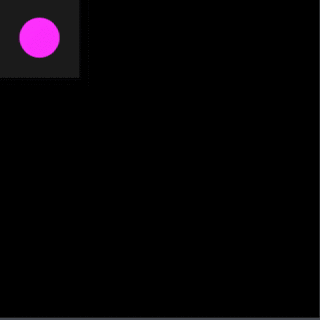CALayer does not animate the same as the UIView animation
Animating layer properties in sync with UIView animation can be tricky. Instead, let's use a different view structure to take advantage of the built-in support for animating a view's transform, instead of trying to animate a layer's path.
We'll use two views: a superview and a subview. The superview is a LogoView and is what we lay out in the storyboard (or however you create your UI). The LogoView adds a subview to itself of class LogoLayerView. This LogoLayerView uses a CAShapeLayer as its layer instead of a plain CALayer.
Note that we only need one CAShapeLayer, because a path can contain multiple disconnected regions.
We set the frame/bounds of the LogoLayerView once, to CGRectMake(0, 0, 213, 213), and never change it. Instead, when the outer LogoView changes size, we set the LogoLayerView's transform so that it still fills the outer LogoView.
Here's the result:

Here's the code:
LogoView.h
#import <UIKit/UIKit.h>
IB_DESIGNABLE
@interface LogoView : UIView
@end
LogoView.m
#import "LogoView.h"
#define CGRECTMAKE(a, b, w, h) {.origin={.x=(a),.y=(b)},.size={.width=(w),.height=(h)}}
const static CGRect ovalRects[] = {
CGRECTMAKE(62.734375,-21.675000,18.900000,18.900000),
CGRECTMAKE(29.784375,-31.725000,27.400000,27.300000),
CGRECTMAKE(2.534375,-81.775000,18.900000,18.900000),
CGRECTMAKE(4.384375,-57.225000,27.400000,27.300000),
CGRECTMAKE(2.784375,62.875000,18.900000,18.900000),
CGRECTMAKE(4.334375,29.925000,27.400000,27.300000),
CGRECTMAKE(62.734375,2.525000,18.900000,18.900000),
CGRECTMAKE(29.784375,4.475000,27.400000,27.300000),
CGRECTMAKE(-21.665625,-81.775000,18.900000,18.900000),
CGRECTMAKE(-31.765625,-57.225000,27.400000,27.300000),
CGRECTMAKE(-81.615625,-21.425000,18.900000,18.900000),
CGRECTMAKE(-57.215625,-31.775000,27.400000,27.300000),
CGRECTMAKE(-81.615625,2.775000,18.900000,18.900000),
CGRECTMAKE(-57.215625,4.425000,27.400000,27.300000),
CGRECTMAKE(-21.415625,62.875000,18.900000,18.900000),
CGRECTMAKE(-31.765625,29.925000,27.400000,27.300000)
};
#define LogoDimension 213.0
@interface LogoLayerView : UIView
@property (nonatomic, strong, readonly) CAShapeLayer *layer;
@end
@implementation LogoLayerView
@dynamic layer;
+ (Class)layerClass {
return [CAShapeLayer class];
}
- (void)layoutSubviews {
[super layoutSubviews];
if (self.layer.path == nil) {
[self initShapeLayer];
}
}
- (void)initShapeLayer {
self.layer.backgroundColor = [UIColor yellowColor].CGColor;
self.layer.strokeColor = nil;
self.layer.fillColor = [UIColor greenColor].CGColor;
UIBezierPath *path = [UIBezierPath bezierPath];
for (size_t i = 0; i < sizeof ovalRects / sizeof *ovalRects; ++i) {
[path appendPath:[UIBezierPath bezierPathWithOvalInRect:ovalRects[i]]];
}
[path applyTransform:CGAffineTransformMakeTranslation(LogoDimension / 2, LogoDimension / 2)];
self.layer.path = path.CGPath;
}
@end
@implementation LogoView {
LogoLayerView *layerView;
}
- (void)layoutSubviews {
[super layoutSubviews];
if (layerView == nil) {
layerView = [[LogoLayerView alloc] init];
layerView.layer.anchorPoint = CGPointZero;
layerView.frame = CGRectMake(0, 0, LogoDimension, LogoDimension);
[self addSubview:layerView];
}
[self layoutShapeLayer];
}
- (void)layoutShapeLayer {
CGSize mySize = self.bounds.size;
layerView.transform = CGAffineTransformMakeScale(mySize.width / LogoDimension, mySize.height / LogoDimension);
}
@end
You can make CAShapeLayer.path animatable and update your custom layer in -layoutSublayersOfLayer. Just make sure to match duration of UIView and CAShapeLayer subclass.
Simple and straightforward:
//: Playground - noun: a place where people can play
import UIKit
import XCPlayground
let kAnimationDuration: NSTimeInterval = 4.0
class AnimatablePathShape: CAShapeLayer {
override func actionForKey(event: String) -> CAAction? {
if event == "path" {
let value = self.presentationLayer()?.valueForKey(event) ?? self.valueForKey(event)
let anim = CABasicAnimation(keyPath: event)
anim.duration = kAnimationDuration
anim.fromValue = value
anim.timingFunction = CAMediaTimingFunction(name: kCAMediaTimingFunctionEaseInEaseOut)
return anim
}
return super.actionForKey(event)
}
override class func needsDisplayForKey(key: String) -> Bool {
if key == "path" {
return true
}
return super.needsDisplayForKey(key)
}
}
class View: UIView {
let shape = AnimatablePathShape()
override init(frame: CGRect) {
super.init(frame: frame)
self.backgroundColor = UIColor.whiteColor().colorWithAlphaComponent(0.1)
self.shape.fillColor = UIColor.magentaColor().CGColor
self.layer.addSublayer(self.shape)
}
required init?(coder aDecoder: NSCoder) {
fatalError("init(coder:) has not been implemented")
}
func yoyo(grow: Bool = true) {
let options: UIViewAnimationOptions = [.CurveEaseInOut]
let animations = { () -> Void in
let scale: CGFloat = CGFloat(grow ? 4 : 1.0 / 4)
self.frame = CGRectMake(0, 0, CGRectGetWidth(self.frame) * scale, CGRectGetHeight(self.frame) * scale)
}
let completion = { (finished: Bool) -> Void in
self.yoyo(!grow)
}
UIView.animateWithDuration(kAnimationDuration, delay: 0, options: options, animations: animations, completion: completion)
}
override func layoutSublayersOfLayer(layer: CALayer) {
super.layoutSublayersOfLayer(layer)
let radius = min(CGRectGetWidth(self.frame), CGRectGetHeight(self.frame)) * 0.25
let center = CGPoint(x: CGRectGetMidX(self.frame), y: CGRectGetMidY(self.frame))
let bezierPath = UIBezierPath(arcCenter: center, radius: radius, startAngle: 0, endAngle: CGFloat(M_PI * 2), clockwise: true)
self.shape.path = bezierPath.CGPath
}
}
let view = View(frame: CGRect(x: 0, y: 0, width: 100, height: 100))
let container = UIView(frame: CGRect(x: 0, y: 0, width: 400, height: 400))
container.addSubview(view)
view.yoyo()
XCPlaygroundPage.currentPage.liveView = container
